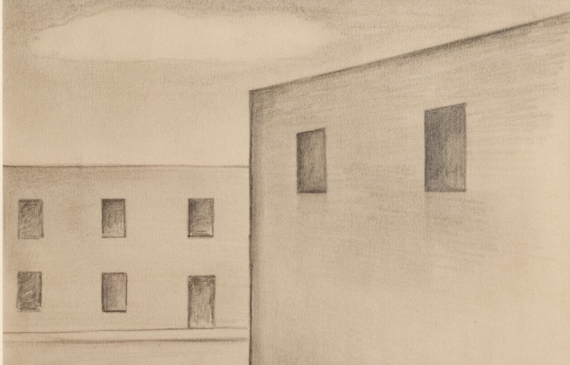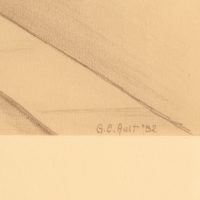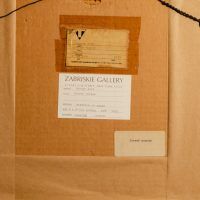


George Copeland Ault (American, 1891 – 1948)
Street Corner, 1932
Graphite on Paper
9 H. x 8 3/4 W. inches.
Provenance:
Purchased at Zabriske Gallery
Bears on Verso Vanderwoude Tennenbaum and Zabriske Gallery labels
|
Born in Cleveland, Ohio in 1891, George Ault spent his youth in London, where his family moved when he was eight. His father’s ink manufacture firm, Ault-Wiborg, introduced American printing ink to Europe. George received his art training at the Slade School of Art and St. John’s Wood School of Art, London. His most important teachers at the Slade School were Henry Tonks and Wilson Steer, artists with ties to the Bloomsbury group. In 1911, when George was twenty, the Ault family moved to New York City. In New York, Ault painted urban vistas similar to those of Joseph Pennell, although he was already interested in night effects, a major theme in many of his later works. George Ault’s art from 1911 to 1920 was executed in an Impressionist style. In 1921, Ault began a series of New York skyscraper subjects of block-like black buildings against a night sky. The facades of the buildings were painted with abstract grids of brightly lit windows. In these urban subjects, Ault found his personal voice. A Surrealist quality entered Ault’s work in 1924 after a trip to Paris. In Ault’s urban subjects, he used odd lighting and empty streets amid industrial buildings to represent uneasy reality. Although Ault did many night scenes lit by the moon or electrical light in the 1920s, he also painted crisply geometric and boldly colored urban architecture against blue skies, wheel driven machinery in his father’s factory, and some still life subjects. During this period, Ault established relationships with a number of progressive dealers and began to develop an artistic reputation. He first exhibited at the Whitney Studio Club in 1922 and continued to do so through the 1920s. He exhibited in the Whitney Museum’s first two biennials in 1932 and 1934. Ault had solo exhibitions at the Bourgeois Gallery (1923), J.B. Neumann’s New Art Circle (1927) and Edith Halpert’s Downtown Gallery (1927, 1928). Ault also was invited to exhibit at the Carnegie International (1941, 1943, 1946) and the Pennsylvania Academy of the Fine Arts (1931, 1934, 1944, 1946). In 1934 Ault began spending his summers in Woodstock, New York and participated in the federal government’s New Deal art projects. By 1937, Ault and his future wife Louise left New York City to move permanently to Woodstock, New York. At his home in the quiet rural town, Ault found respite and order in a life devoted to household chores, yard work, and the meticulous execution of his paintings. Woodstock inspired Ault to paint landscapes and make fewer of the urban subjects that dominated his New York work. In Ault’s Woodstock landscapes, nature is presented as a minutely observed portrait. Ault continued to find architectural shapes in the landscape around Woodstock such as aging barns or ancient trees. The surreal quality Ault invested in these shapes gave him the opportunity to express his own emotions. Between 1932 and his death in 1948, Ault focused on the cross roads at Russell’s Corners. In a career that had focused continuously on the revelation of architectural structures by night lighting, the Russell’s Corners series are some of Ault’s strongest paintings. These Woodstock paintings were the focus of a major traveling exhibition, To Make a World: George Ault and 1940s America, which opened at the Smithsonian American Art Museum in 2011. George Ault’s work is in the collections of the Brooklyn Museum, Cleveland Museum of Art, Los Angeles County Museum of Art, Metropolitan Museum of Art, Museum of Modern Art, Newark Museum, Pennsylvania Academy of the Fine Arts, Philadelphia Museum of Art, and the Whitney Museum of American Art. |